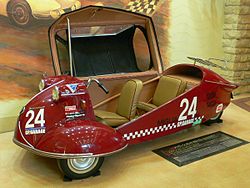- Messerschmitt KR175
-
Messerschmitt KR175 
Manufacturer Regensburger Stahl- u. Maschinenbau, Regensburg, Germany Also called Kabineneroller, Karo
Mivalino (license-built in Italy)[1]Production 1953–1955 Assembly Regensburg, Germany
Brescia, Italy, under license[1]Predecessor none Successor Messerschmitt KR200 Class microcar Body style coupe, roadster Layout RMR layout Platform Messerschmitt Kabinenroller Engine Fichtel & Sachs two-stroke single cylinder, pull start or optional electric start[2] Transmission Four forward speeds, sequential, unsynchronized.[2] Wheelbase 2.029 m (6 ft 7.9 in)[3] Length 2.820 m (9 ft 3.0 in)[3] Width 1.220 m (4 ft 0.0 in)[3] Height 1.200 m (3 ft 11.2 in)[3] Curb weight 220 kg (490 lb)[3] Related Messerschmitt KR200
FMR Tg500Designer Fritz Fend The Messerschmitt KR175 bubble car (1953–1955) was the first vehicle built by Messerschmitt under its 1952 agreement with Fritz Fend. In concept, although not in actual design, it was an extended version of the Fend Flitzer invalid carriage. Approximately 15,000 were built before it was replaced by the Messerschmitt KR200 in 1956.[4]
Contents
History
Messerschmitt, temporarily not allowed to manufacture aircraft, had turned its resources to producing other products. In 1952, Fend approached Messerschmitt with the idea of manufacturing small motor vehicles.[5] These were based on his Fend Flitzer invalid carriage.[6]
The first of Fend's vehicles to enter production at Messerschmitt's Regensburg factory was the KR175.[3] The title Kabinenroller means "scooter with cabin".[7] While the Messerschmitt name and insignia were used on the car, a separate company, incorporated as Regensburger Stahl- und Metallbau GmbH, was created to manufacture and market the vehicle.[3]
There were several problems with the first KR175s to be built, resulting in 70 design modifications between the beginning of production in February 1953 and June of the same year.[4]
The KR200 was developed from the KR175 and replaced it in 1955.[3]
Features
The KR175 established several features unique to the Kabinenroller platform. Externally, the narrow body, the transparent acrylic bubble canopy and low stance were among the more obvious features.
Tandem seating
The narrow body, and corresponding low frontal area, was achieved with tandem seating, which also allowed the body to taper like an aircraft fuselage, within a practical length.[citation needed] The front fenders did not have wheel cutouts.[6]
Bubble canopy
Entry to the KR175 was through a canopy door hinged on the right side of the vehicle. The door included all the windows (windshield on both models, window frames and acrylic bubble on closed version) and the frame in which they were set, extending from the right side of the monocoque tub to the left.
The bubble went completely around the cockpit with cutouts for window frames at the sides and a small, flat glass windshield at the front. The windshield wiper was manually operated.[6]
Engine and transmission
The KR175 ran on a 173 cc (10.6 cu in) Fichtel & Sachs air-cooled single cylinder two-stroke engine positioned in front of the rear wheel,[2] just behind the passenger's seat.[6] The engine was started with a pull rope as standard, but there was an option of an electric starter. The transmission was a sequential, positive-stop type with four speeds and no synchronization nor reverse gear.[2]
Controls
The KR175 was steered with tubular steel handlebars. Operated by pushing rather than by turning, the steering bar was connected directly to the track rods of the front wheels, providing an extremely direct response best suited to small, measured inputs[3]. The gearshift lever, on the right side of the cockpit, had a secondary lever on it which operated the clutch.[2]. The throttle was operated by a twist-grip on the left handlebar.[3] The footbrake pedal, which was the only pedal in the car, operated brakes on all three wheels mechanically, using cables. The handbrake lever operated similarly.[2].
Mi-Val Mivalino
Italian motorcycle manufacturer Metalmeccanica Italiana Valtrompio s.p.a., makers of the brand Mi-Val, assembled KR175s in Brescia, Italy, using components imported from Messerschmitt but with their own 172 cc (10.5 cu in) two-stroke engine installed. These cars were sold as the Mi-Val Mivalino.[1]
Data
- Configuration: mid (rear) engine, rear drive
- Seating, front/rear: 1/1
- Weather protection: bubble canopy coupe, convertible or open roadster
- Heating/air conditioning: none/none
- Engine type: Fichtel & Sachs, 1 cylinder, 2 stroke
- Displacement: 174 cc
- Bore x stroke— 62 x 58 mm
- Compression: 6.8:1
- Power: 6.7 kW (9.0 hp) @ 5,250 rpm
- Cooling: air, with fan
- Starter: kick starter, later Dynastart
- Drive: 4 speed and chain to single rear wheel
- Brakes: 3 wheel
- Wheel size: 4.00 by 8 in
- Dimensions (length/width/height) (m): 2.820 m (111.0 in)/1.220 m (48.0 in)/1.200 m (47.2 in)
- Wheelbase: 2.030 m (79.9 in)
- Track, front/rear: 0.920 m (36.2 in)/0 m.
- Weight, empty/full load: 210 kg (460 lb)/360 kg (790 lb).
- Fuel consumption: 3.7 L/100 km (76.3 mpg-imp; 63.6 mpg-US)
- Top speed: 80 km/h (50 mph)
- Years built: 1953 to 1955
- Number built: 15,000 (19,668 from another source)
- Price : DM 2,100.00
See also
Notes
References
- Wagner, Carl (Second Quarter 1973). ""Ist das nicht ein Kabinenroller?" "Ja! das ist ein Kabinenroller!" Carl Wagner takes off on Messerschmitt" (in US English). Automobile Quarterly (40 East 49th Street, New York, NY 10017 USA: Automobile Quarterly Inc.) 11 (2): 162–171. Library of Congress Catalog Card Number 62-4005.
- "Bruce Weiner Microcar Museum: 1954 Mivalino". The Bruce Weiner Microcar Museum Inc.. http://www.microcarmuseum.com/tour/mivalino.html. Retrieved 23 August 2008.
- "Bruce Weiner Microcar Museum: 1954 Messerschmitt 175". The Bruce Weiner Microcar Museum Inc.. 2007. http://www.microcarmuseum.com/tour/messerschmitt-kr175-white.html. Retrieved 23 August 2008.
External links
Categories:- Microcars
- Three-wheeled motor vehicles
- First automobile made by manufacturer
- Rear mid-engine, rear-wheel drive vehicles
Wikimedia Foundation. 2010.



